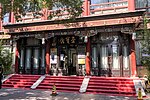Xuanwumen station

Xuanwumen Station (simplified Chinese: 宣武门站; traditional Chinese: 宣武門站; pinyin: Xuānwǔmén Zhàn) is an interchange station between Line 2 and Line 4 of the Beijing Subway. It is named for Xuanwumen, a former gate in Beijing's city wall that was demolished during construction of the subway. The station opened in 1971 and handles an average of 350,000 passengers per day in 2012. Interchange volumes can reach per hour can reach 15,000 passengers per hour in the morning peak. The large transfer volumes overwhelm the small interchange corridors, which can narrow to only 2.4 meters in width. Three new transfer corridors were added in 2020, increasing transfer capacity of the station six-fold to around 55,000 passengers per hour.
Excerpt from the Wikipedia article Xuanwumen station (License: CC BY-SA 3.0, Authors, Images).Xuanwumen station
Xisongshu Alley, Xicheng District Xichang'anjie (首都功能核心区)
Geographical coordinates (GPS) Address Nearby Places Show on map
Geographical coordinates (GPS)
| Latitude | Longitude |
|---|---|
| N 39.8997 ° | E 116.3743 ° |
Address
西松树胡同
Xisongshu Alley
100032 Xicheng District, Xichang'anjie (首都功能核心区)
Beijing, China
Open on Google Maps








